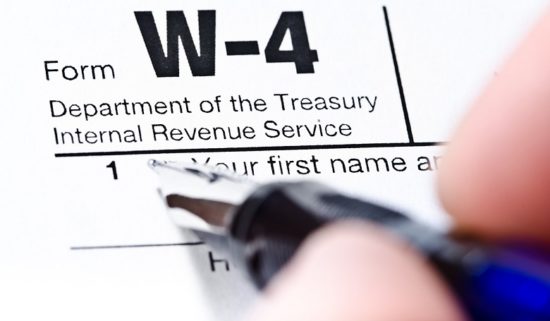Did your paycheck increase due to the recent tax cuts? Many Americans saw a change in their take-home pay beginning in February once the IRS issued its new tax withholding tables.
 Businesses adjusted the withholding for their employees according to the new tables. To avoid a tax surprise in 2019, you may need to make adjustments to your withholding as well.
Businesses adjusted the withholding for their employees according to the new tables. To avoid a tax surprise in 2019, you may need to make adjustments to your withholding as well.
Even if there’s little or no change in your paycheck, it’s wise to check your withholding status on your W-4 form. The Tax Cuts and Jobs Act changed the threshold dollar amounts for tax brackets, removed the personal exemption, and changed various tax deductions and credits.
Changing Tax Bill
Your 2018 tax bill could change as a result – for example, if you land in a new tax bracket or it no longer makes sense for you to itemize deductions.
How do you know if you need to adjust your withholding? Every year, the IRS issues instructions for the W-4 form that includes a worksheet to calculate your personal allowances. The IRS also provides an online withholding calculator that will take care of the calculations for you.
If you determine that you need to change your withholding, you must fill out a new W-4 and submit it to your employer. The calculator or worksheet will provide you with the information you need to fill out the new form.
Do It Early
It’s important to submit the new form as early as possible, especially if you need to increase your withholding amount. In that case, your taxes will be slightly underpaid each pay period until you make the adjustment – and the adjustment you eventually make will have to be larger to make up the difference.
A lower number of personal allowances withholds more from your paycheck. Your take-home pay will decrease, and you’ll see the larger withholding value noted in your check stub. Conversely, a higher number of personal allowances decreases your withholding and increases your take-home pay.
If you’re concerned that your estimates are off – or you just like getting a large refund – you can fill in a lower number than the worksheet or calculator predicts. You can also add an extra dollar amount to withhold over and above your personal allowances. Simply write in the amount on line 6 of the W-4 form.
Keep Your Money
As great as a refund sounds, realize that getting a tax refund means you overpaid the government throughout the year. Try to make your withholding as accurate as possible. Why let the government make interest on your money when you could be investing it instead?
We suggest checking your withholding again later in the year to make sure that you’re still on target to meet your estimated tax bill. In addition, be sure to update the W-4 any time you have major income or life changes that will impact your taxable income or tax status.
Remember that the changes you are making now will affect the tax bill (or refund) due in April 2019. The bill or refund that you got in April 2018 is for the income you earned in 2017 and the withholding that accumulated throughout that year.
Don’t let your bill for the 2018 tax year catch you by surprise. Take a few moments to review your withholding and make any adjustments now.
Wait too long in the year and you’ll have to make a much larger adjustment in your take-home pay to make up the difference – or you may have to write a big check to the IRS in April 2019.
This article was provided by our partners at moneytips.com. Photo ©iStockphoto.com/alexdobysh
Read More
If you liked this article, you just might enjoy these others from our archives:
Readers, if reading our blog posts make you want to try your hand at blogging yourself, we have good news for you: You can do exactly that on Saving Advice. Just click here to get started.